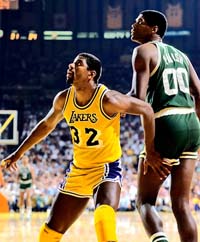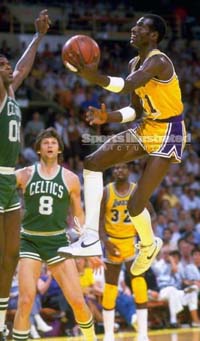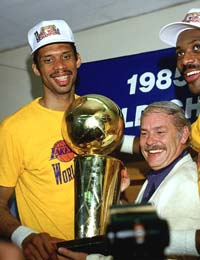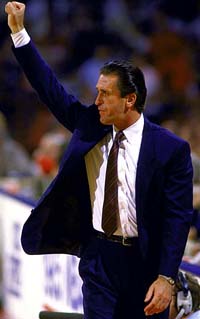|
Basketball
Snapshots - 3
The City College of New York
has not been a basketball power for over 50 years. However, CCNY (often called just "City")
holds a distinction that will never be duplicated. In 1950, the Beavers
– strange
nickname for a Big Apple school – won both the NIT and the NCAA championships in the same year.
CCNY's
coach was the legendary Nat
Holman. A member of the Original
Celtics, he was voted the third best player of the
first half of the 20th century (behind George
Mikan and Hank
Luisetti). Nat began coaching CCNY
in 1919 while still a player. His 1948 recruiting class was one
of the best in the nation. Since freshmen were ineligible, they
waited a year to show what they could do. The starting five, all
from New York City of course, consisted of two seniors, Irwin
Dambrot and Norm Mager, and three sophs:
Ed Warner, Al Roth, and Floyd
Layne. Warner and Layne
were African-American. Dambrot, Mager,
and Roth were Jewish (like Holman
himself). They were all sons of immigrants (as was Nat)
or grandsons of slaves. |
|
Ranked
as high as #7 in the AP poll early in the season, the team slumped to
a 17-5 record. The National Invitation Tournament (NIT), considered the
most prestigious at the time, was held immediately after the season in
Madison
Square Garden where CCNY
played its city rivals. The Beavers
got the 12th and last spot in the field because they swept the "subway
series" over the other NYC schools.
They
upset the defending NIT champion San Francisco
65-46. The next opponent was #3 Kentucky,
whose coach was a well-known racist. Marvin Kalb, CCNY
'51 and longtime CBS news reporter, has said: "It was not a basketball
game. It was a cultural war, a religious war. It was City
College's way of saying, '... screw you, Adolph
Rupp. We are also part of this country. It is not just yours.
It is ours, too.'" CCNY
routed the Wildcats 89-50,
the worse defeat in Rupp's career. (The Kentucky flag
at the state capitol was flown at half mast the next few days.)
#6
Duquesne fell in the semis,
62-52. #1 Bradley was the
finals opponent. Holman dragged himself out of bed with
a 103-degree fever to coach his team to a 69-61 victory.
The
NCAA had held one spot open in its eight-team field. It gave it to CCNY
and placed them in the East regional held, fortuitously, at MSG, which
would also host the finals. The Beavers
eked out a 56-55 squeaker over #2 Ohio State,
then beat #5 North Carolina State
78-73. Who then came to New York from the West regional to play in the
finals? None other than the Bradley Braves
, the same team CCNY
had upset in the NIT finals. Played before another packed house of 18,142,
the game was closer than the first one. City
led by one with 10 seconds left when Bradley's
leading scorer Gene Melchiorre drove the lane and collided
with Dambrot. No foul was called (home cooking?) and
Dambrot threw a long pass to Mager for
the clinching basket in a 71-68 victory.
CCNY
thus became the first NCAA champion to have African-American players in
its starting lineup. With three starters and several key reserves returning,
the team looked forward to 1950-1. However, disaster struck in the form
of a point-shaving scandal. But we'll leave that story for another episode
of "Basketball Snapshots."
Watch
a ThinkTank
episode about the 1950 CCNY
basketball team. Put CCNY
in the Search box.
|
This Snapshot is the tragic follow-up to the previous
one (above) about the CCNY
(City
College of New York)
team of 1949-50 that won both the NIT and NCAA tournaments.
On
February 18, 1951, four CCNY
players, starters Al Roth, Ed Warner,
and Ed Roman, were arrested in Penn Station when they
returned from defeating Temple 95-71 in Philadelphia.
The New York District Attorney's office charged them with bribery. The
next month, another member of the team, Floyd Layne,
plus two graduates from the previous year, Irwin Dambrot
and Norm Mager, were also arrested in connection with
a point-shaving scandal that rocked the sports world. Basically, the players
accepted money from gamblers to make sure their teams did not cover the
point spread.
The
investigation uncovered the fact that, of CCNY's
five losses during its championship run, three had been fixed. Further,
the players continued to "dump" games during the 1950-1 season.
Roth confessed and entered the army in order to avoid
a six-month sentence. All the remaining players received suspended sentences.
At
first, the scandal was limited to the New York area as players at
Manhattan, New York
University (NYU),
and Long Island University
(LIU, coached by the legendary
Clair
Bee) were also charged, including LIU's
Sherman
White, the nation's leading scorer in 1951. (His title was
voided and given to Temple's Bill Mlkvy.)
However, the FBI got involved and found a web of deceit that enveloped
schools elsewhere.
- The
most shocking was Kentucky,
which won the 1951 championship over Kansas
State in Minneapolis. Coach Adolph Rupp
boasted "The gamblers couldn't touch my boys with a 10-foot pole."
However, he learned in October that three of his "boys" were
arrested, including NBA All Stars Alex Groza and Ralph
Beard. NBA Commissioner Maurice Podoloff suspended
Groza and Beard indefinitely and barred
all other conspirators from playing in the league. The
NCAA subsequently imposed so many restrictions on Kentucky
for 1952-3 that the school decided not to field a team that season.
- The
7-foot junior center Bil
Spivey of the 1951 champs was caught in the web and
became basketball's version of "Shoeless Joe"
Jackson. Bil was charged with perjury
for refusing to testify against the others. His case was dismissed
when the jury deadlocked 9-3 in favor of acquittal. However, he
never played another game in college or the NBA. He did win a $10,000
judgment against the NBA for barring him unfairly.
- The
scandal also stung Bradley,
the team CCNY
defeated in both the NIT and NCAA finals in 1950. Star guard Gene
Melchiorre and four teammates admitted taking bribes to
hold down the score against St. Joseph's and Oregon
State in 1951.
The
final tally showed that 32 players at seven schools (Toledo
being the seventh) conspired
to fix 86 games in 23 cities in 17 states between 1947 and 1951.
Although
not involved himself, long-time CCNY
coach
Nat Holman was devastated by the revelations. The New
York City Board of Higher Education also found that the high school records
of 14 players at NYC colleges
had been doctored to make them eligible for admission. CCNY
subsequently deemphasized basketball in 1953, in part because the team
was banned from playing in Madison Square Garden. The scandal is credited
with ending New York City's reign as the center of the college basketball
world.
|
As this is written, all signs point to another Lakers-Celtics final in the NBA. So let's turn back the clock to 1985 when those teams met in the Finals for the ninth time.
- Boston had won the first eight matchups, including the first one, 1959, when the Lakers were still in Minneapolis. The Lakers had won three championships since moving to L.A. but none had come against the Celtics.
- The latest conquest had come the year before when Larry Bird took the MVP award in the seven-game Celtic triumph. Averaging 27.4 ppg and 14 rpg, the former Indiana State star was considered to have soundly outplayed his rival, Magic Johnson (18.0, 7.7), who committed a crucial turnover in the last minute of the final game. He had also made several other errors in crunch time in Game 4.
- The seventh game had drawn the largest TV audience ever for an NBA contest and the second largest basketball rating behind only the Johnson-Bird confrontation in the 1979 NCAA Finals. It was the last finals played in the 2-2-1-1-1 format.
- The Celtics had rubbed in the victory. Kevin McHale referred to the Lakers' star G as "Tragic Johnson." Asked about the 1984-85 season, Bird said of the Lakers, "I'd like to give them the opportunity to redeem themselves. I'm sure they have guys who feel they didn't play up to their capabilities." Everyone knew who he meant.
Because the Celtics had one more regular season win than L.A., the series opened in the Boston Garden, where the Lakers inexplicably began with a pitiful performance.
- In what was dubbed the Memorial Day Massacre, Boston thumped LA 148-114 in Boston Garden. Kareem Abdul-Jabbar had only 12 points and 3 rebounds against Celtic C Robert Parish. Afterwards, he apologized to his teammates. Magic pulled down only a single RB.
- Kareem recalls: "We had a film session the day after, and coach Pat Riley was very angry. It took a couple of hours to get through – that's how bad I was. ... But we had good practices after that ... Maybe Boston had a little too much time between games to be satisfied, and they took us lightly in Game 2. When we came out and won, it surprised them a little. I played much better that game, and even though Game 1 had been so bad, we had gotten a split on their home court and that was all that mattered."
- The Lakers won 109-102, as Kareem had 30 points, 17 rebounds, 3 blocked shots, and 8 assists. Laker swingman Michael Cooper contributed 22 points on an 8 for 9 shooting performance.
Under the new format, patterned after the World Series, the teams moved to the West Coast for three games.
- The Lakers almost reversed the margin from Game One, pulling away in the second half for a 136-111 victory. Kareem became the all-time leading playoff scorer. Bird shot only 17-for-42. Hampered by a bad back and sore right elbow, he also faced constant harassment by Cooper.
- After two subpar performances, the Celtics ralled to even the series, 107-105, on Dennis Johnson's jumper at the buzzer. It would turn out to be their last gasp.
- In the pivotal Game Five, the Lakers led 89-72 before K. C. Jones' team cut the margin to four with six minutes. But Magic scored three baskets and Kareem four more to prevail 120-111.
Boston needed to win Game Six on its home court to prolong the series.
- Kareem scored 29 as the Lakers defeated the Celtics 111-100. Bird's shooting woes continued (12-for-29). The victory marked the first time – and, to date, the only time – a team claimed an NBA championship in Boston Garden (or its successor).
- The Lakers C recalls: "Magic Johnson was terrific in that final game, and James Worthy seemed like he was making every shot. But the thing I remember most about the series is the excitement of going back to L.A. as champions – not just champions but beating Boston to do it. That was something that the Lakers had never done all those decades, so it was a very big monkey off our backs."
- Abdul-Jabbar was the clear choice for MVP. He averaged 30.2 points, 11.3 rebounds, 6.5 assists and 2.0 blocks. At age 38, he became the oldest player to win a Finals MVP award.
- Riley said afterwards about the opening massacre: "That game was a blessing in disguise. It strengthened the fiber of this team. After that, Kareem had this look, this air about him."
Reference: "I Remember ... Kareem Abdul-Jabbar," Sporting News, 05/24/2010
|

Larry Bird, Dennis Johnson, Kevin McHale

Magic Johnson and Robert Parish

Michael Cooper

Kareem Abdul-Jabbar, owner Jerry Buss, and James Worthy

Pat Riley
|
|
CONTENTS
CCNY Wins NCAA and NIT
CCNY Gambling Scandal
Revenge Is Sweet
Basketball
Snapshots Index
Basketball
Magazine
Golden Rankings Home
CONTENTS
CCNY Wins NCAA and NIT
CCNY Gambling Scandal
Revenge Is Sweet
Basketball
Snapshots Index
Basketball
Magazine
Golden Rankings Home
CONTENTS
CCNY Wins NCAA and NIT
CCNY Gambling Scandal
Revenge Is Sweet
Basketball
Snapshots Index
Basketball
Magazine
Golden Rankings Home
CONTENTS
CCNY Wins NCAA and NIT
CCNY Gambling Scandal
Revenge Is Sweet
Basketball
Snapshots Index
Basketball
Magazine
Golden Rankings Home |





